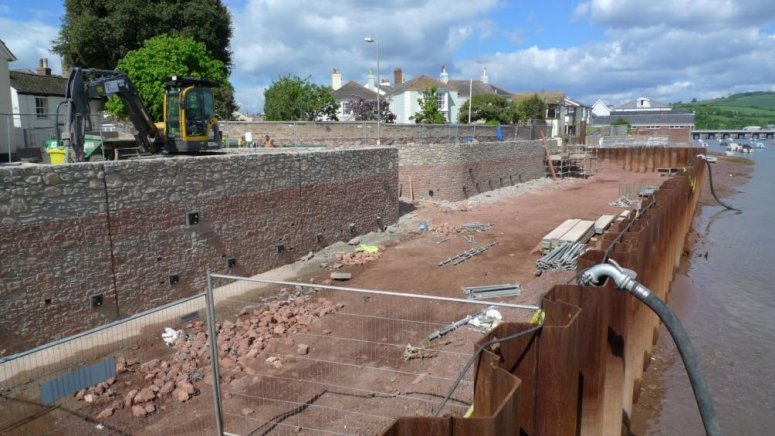
Following two near-miss flooding events in October 2004 and March 2008, the Environment Agency (EA) and contractors Interserve designed tidal defences for Shaldon and Ringmore on the Teign Estuary, South Devon.
Seawalls are usually seen only as flood alleviation structures rather than as having other possible functions to benefit the wide environment. Where new walls are being installed there is opportunity to include more sympathetic “nature friendly” textured finishes to improve or maintain biodiversity. Where seawalls are already installed, retrofit enhancement measures provide significant opportunities. Small alterations were made to the mortar pointing between decorative stone cladding of a section of vertical concrete wall during construction of the Shaldon and Ringmore Tidal Defence Scheme. Based on evidence from existing scientific studies, niche habitats (grooves, holes and mini-pools) were created during construction to provide cool/moist refuge for intertidal wildlife at low tide, at three different heights on the wall. Ecological use of these features was compared with adjacent sections of unmodified wall.
Designed to reduce the risk of tidal flooding to 453 homes and businesses in Shaldon and Ringmore. The first example of the EA’s ‘Building Trust with Communities’ approach to public engagement. Started Jan 2010, completed June 2010.
Small alterations were made to the mortar pointing between decorative stone cladding of a section of vertical concrete wall during construction of the Shaldon and Ringmore Tidal Defence Scheme. Based on evidence from existing scientific studies, niche habitats (grooves, holes and mini-pools) were created during construction to provide cool, moist refuge for intertidal wildlife at low tide, at three different heights on the wall. Ecological use of these features was compared with adjacent sections of unmodified wall.
Environmental outcomes
After a period of 18 months post-construction, nine invertebrate species were found in association with the enhancements. Grazing species (snails) were most commonly found in the ‘holes’ and ‘pools’ habitats, which retained water at low tide. The ‘pool’ habitat supported significantly more species than adjacent, smoother sections of wall after this period, including snails, barnacles and algae. Overall, inclusion of the enhancement led to a greater abundance and diversity of species compared to comparable sections of wall without enhancements.
Ecosystem services
The enhanced wall is successfully functioning as an intertidal habitat, helping support local biodiversity, and compensating for some loss of foreshore (approximately 1m) due to the footprint of wall.
- Developing climate change adaptation; improving risk management and resilience
- Better protection and restoration of coastal ecosystems
- Reduce flood risk
- Restoring ecosystems and their functions
- Increase Biodiversity
This scheme shows that ecological enhancements can be designed and incorporated into an operational tidal defence scheme at Shaldon. It illustrates how future schemes can include ecological enhancement in the design and build process and what kinds of enhancements might be considered.
A subsequent 18 month report (Coombes et. al., 2012) stressed strongly, however, that "the feasibility, practicality and expected outcomes of ecological enhancement may vary considerably between different locations depending on many factors".
Scaling up the benefits
The kinds of simple enhancements used at Shaldon could be scaled-up to whole defence schemes with minimal additional costs. For this particular scheme, 340 metres of existing foreshore walls were replaced, of which only a 20 m was enhanced. Based on £1000 additional construction costs for including similar niche habitats per 10 m section, the cost of enhancing the entire scheme would be estimated to be £34,000, equivalent to 0.5% of the total scheme costs.
The ecological benefits of the enhancement are very localised as only a short section of wall was enhanced. Application of these techniques to entire schemes, and to multiple schemes along a coastline, would help support local and regional-scale biodiversity, particularly in light of habitat losses resulting from necessary coastal protection works and coastal squeeze.
Reference.
Coombes, M.A., Naylor, L.A., Jackson, J., Thompson. R.C., 2012. Shaldon and Ringmore Tidal Defence
Scheme: Ecological Enhancement Monitoring Report (18 months post-construction). Report to the
Environment Agency by the University of Exeter and University of Plymouth. 20pp.
The scheme was driven by a need to repair the existing sea defence in a sympathetic
and visually acceptable way (within a historic conservation area) and to examine the potential to include ecosystem enhancement techniques.
The research shows that it these small-scale enhancements are valuable in including habitat where there would be little or none if traditional methods were used. Historic England has led much work in the UK on the economic values of historic sites, (cultural, aesthetic, educational value) but as yet there is little data on ecological enhancement values.
The habitats here are relatively small but the positive results indicate significant benefits may be possible, e.g. for current or future priority species. To this end the scheme achieved the goal of demonstrating the capacity for habitat to be built into hard, engineering-centric structures, and illustrates the potential for these schemes to provide ecosystem enhancements.
The benefits from these greener approaches could be scaled-up to incorporate more habitat. Similar adapted niche habitats might provide interesting features on other restoration projects.
Contacts:
Dr. Deborah Dunsford, Environment Agency,
Dr. Larissa Naylor: larissa.naylor@glasgow.ac.uk,
@biogeomorph
